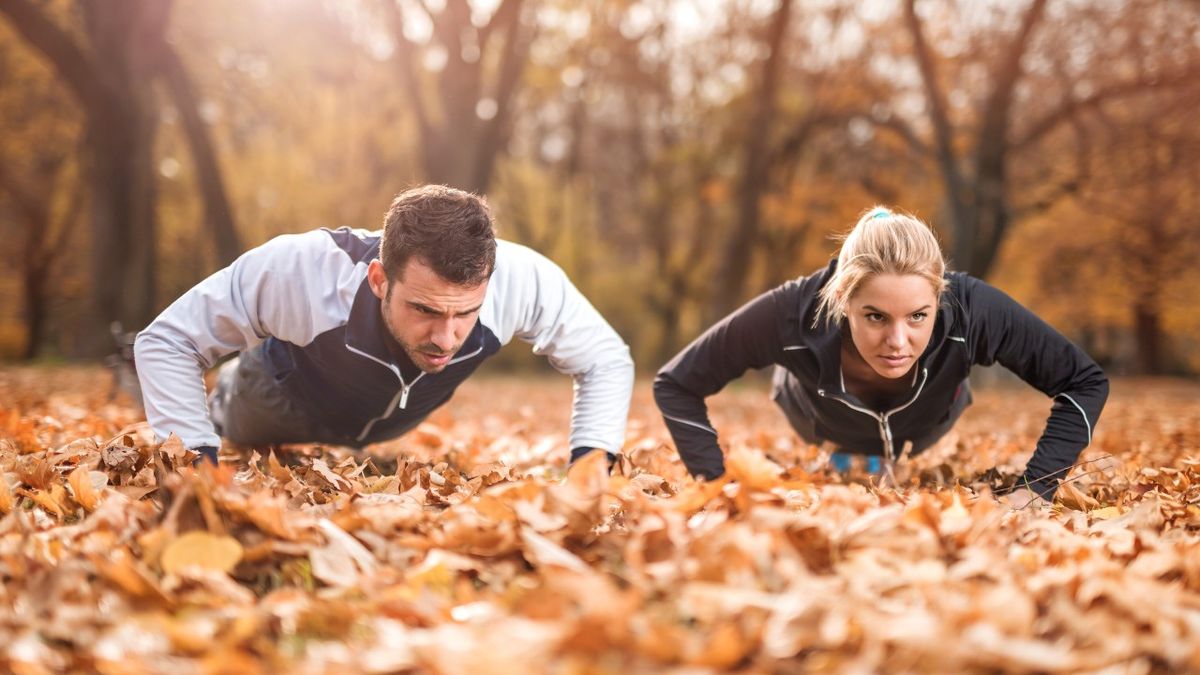Any time you can take your exercise outside, it’s worth doing as far as we’re concerned. The mental health benefits of simply being in the open air, ideally in a green space, add to the physical benefits of your workout – and if it’s warm enough to wear short sleeves you’ll also give your body a chance to produce vitamin D. This HIIT bodyweight workout is an ideal session to tackle in your local park, especially because you’ll need the space to do the shuttle runs involved.
You might argue that being outside means you risk getting cold, but there’s little risk of that when tackling this 30-minute HIIT session. It’s been designed by Jon Boyton, 20 times national kayak champion and an ambassador for GB Active (a bootcamp run by former Team GBers on London’s Clapham Common), and we guarantee it’ll get the heart pumping and melt any frosty feelings.
Along with keeping you warm, the workout improves your cardiovascular fitness as well as targeting muscles all over the body.
“Doing short-duration high-intensity efforts with little rest is a good way to elevate the heart rate into the aerobic development zone,” says Boyton. “This strengthens the heart and allows it to pump more blood around the body. More blood means more oxygen to the working muscles, so your fitness improves.”
If this hits the spot, we have plenty more HIIT workouts for you to try.
Training Tips
Along with the workout below, Boyton gave us the top three training tips he has picked up over his illustrious career.
- “Set short-term realistic, achievable goals that will help you move towards you long-term aims. Breaking down your ultimate goal into smaller chunks can make it less daunting and help concentrate the mind on the task at hand.”
- “Establish a good routine with regards to training, rest, and nutrition. Don’t make excuses to deviate from this routine. Remember that we are only human, though – sometimes unexpected things happen, so when they do don’t beat yourself up about it.”
- “Get a good social group of like-minded people together to train with. Keep everything positive and push each other on to achieve more. A bit of team spirit goes a long way!”
30-Minute Full-Body HIIT Bodyweight Workout
The workout is broken down into five six-minute sections, with each section focusing on a different exercise. The work and rest periods vary for each exercise, so make sure you have something to remind you what they are

Sets 6 Time 30sec Rest 30sec
How From a standing position drop down and kick your feet out behind you so you’re in an elevated press-up position. Lower into a press-up, then push back up, jump your feet up to your hands, and then stand and jump straight up in one smooth motion. Land softly to complete one burpee and go straight into the next.
Why “The burpee’s a great whole-body exercise,” says Boyton. “Working big muscle groups requires more energy and therefore puts a greater demand on the heart, increasing heart rate.”
2 Sit-up

Sets 3 Time 60sec Rest 60sec
How Lie with your back on the ground, knees bent and feet flat on the floor. Brace your abs and raise your shoulders towards your knees. Lower slowly back to the start.
3 Shuttle runs

Sets 2 Time 90sec Distance 10m Rest 90sec
How Set up two markers 10m from one another and sprint between them as many times as possible in the work period.
Why “Shuttle runs work the big lower-body muscle groups,” says Boyton. “Plus every time you accelerate and decelerate this requires more energy, again increasing heart rate.”
4 Double leg lower

Sets 3 Time 60sec Rest 60sec
How Lie on your back with your legs raised straight and perpendicular (or as close to perpendicular as you can get) to the ground. Lower both legs slowly at the same time until your feet are just above the ground, then raise them back to the starting position.
Why “Double leg lowers work the abdominal muscles,” says Boyton. “Doing them in a controlled way strengthens your core muscles as you work to maintain good form.”
Sets 6 Time 30sec Rest 30sec
How Drop to the ground supporting your body with your hands and toes, forming a straight line between your shoulders and feet. Lower until your chest is close to the ground, then push back up to the starting position.
Why “Press-ups strengthen the pectorals, triceps and deltoids as well as working the core muscles as you keep your body straight,” says Boyton.
GB Active puts on fitness classes led by some of the UK’s leading athletes. For more see gb-active.co.uk (opens in new tab)
